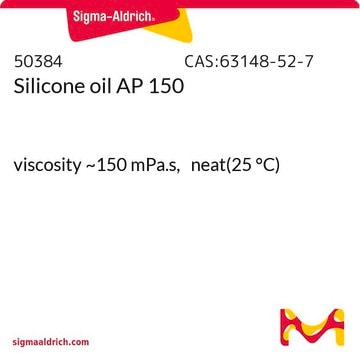85409
Silicone oil
for oil baths (from −50°C to +200°C)
Synonym(s):
Dimethyl polysiloxane
Sign Into View Organizational & Contract Pricing
All Photos(1)
About This Item
Linear Formula:
[-Si(CH3)2O-]n
CAS Number:
MDL number:
UNSPSC Code:
12352100
NACRES:
NA.21
Recommended Products
grade
for oil baths (from −50°C to +200°C)
Quality Level
vapor density
>1 (vs air)
vapor pressure
<5 mmHg ( 25 °C)
5 mmHg ( 20 °C)
form
oil
refractive index
n20/D 1.403 (lit.)
n20/D 1.406
viscosity
100 mPa.s(20 °C)
bp
>140 °C/0.002 mmHg (lit.)
density
0.967 g/mL at 20 °C
Looking for similar products? Visit Product Comparison Guide
General description
Silicone oil is typically used for oil baths in research labs for reactions that require heating/reflux temperatures in the range of -50°C to +200°C. Oil baths provide more uniform heat in comparison to other heating devices.
Silicone oil is useful for the preparation of oil baths having a temperature in the range of -50°C to +200°C.
Application
Silicone oil has been used for the protection of carbon steel alloy samples in a study. Silicone oil has also been used as a heat reservoir during NMR (Nuclear Magnetic Resonance) analysis.
Storage Class Code
10 - Combustible liquids
WGK
WGK 1
Flash Point(F)
214.0 °F - closed cup
Flash Point(C)
101.1 °C - closed cup
Personal Protective Equipment
dust mask type N95 (US), Eyeshields, Gloves
Choose from one of the most recent versions:
Already Own This Product?
Find documentation for the products that you have recently purchased in the Document Library.
Customers Also Viewed
Low-temperature atomic layer deposition of Al2O3 thin coatings for corrosion protection of steel: surface and electrochemical analysis.
Diaz B, et al.
Corrosion Science, 53(6), 2168-2175 (2011)
M Findeisen et al.
Magnetic resonance in chemistry : MRC, 45(2), 175-178 (2006-12-13)
Most established NMR thermometers rely on temperature-dependent chemical shift differences measured from samples that are either neat or concentrated solutions (e.g. ethylene glycol, methanol). These are unsuitable for modern cryoprobes on account of strong radiation damping resulting from the high
Karthik R Balakrishnan et al.
Lab on a chip, 13(7), 1302-1307 (2013-02-07)
Resistive-pulse sensing (RPS), which is based on measuring the current pulse produced when a single particle transits a pore or channel, is an extremely versatile technique used to determine the size and concentration of cells and viruses and to detect
John R Fowler et al.
The Orthopedic clinics of North America, 44(3), 425-431 (2013-07-06)
Radial head fractures without associated bony or ligamentous injury can be safely treated with internal fixation, if possible, or arthroplasty if nonreconstructable. However, nonreconstructable radial head fractures in association with elbow dislocation and/or ligamentous injury in the elbow or forearm
Florent Badique et al.
Biomaterials, 34(12), 2991-3001 (2013-01-30)
We have recently demonstrated strong nuclear deformation of SaOs-2 osteosarcoma cells on poly-L-lactic acid (PLLA) micropillar substrates. In the present study, we first demonstrated that chemical and mechanical properties of the micropillar substrates have no dominant effect on deformation. However
Our team of scientists has experience in all areas of research including Life Science, Material Science, Chemical Synthesis, Chromatography, Analytical and many others.
Contact Technical Service



